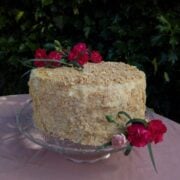Thick Creamy Mayonnaise was one of the dressings they taught me in Culinary school. It’s so easy to make but there a few essential tips to know in order to make a thick mayo every time like the store-bought stuff.

I use this homemade mayonnaise recipe in place of my favorite store-bought one (Hellman’s fan). In fact, I haven’t purchased mayonnaise in over a year now. It’s stable, long-lasting (thanks to the acidic ingredients), and my most go-to staple for making other creamy dressings at home.
I’m trying to stay away from soybean oils so, finding a replacement was vital. Look no further for a Copycat Hellman’s Mayonnaise recipe! This mayo tastes like the real deal (read all the highly-rated five star reviews) and see for yourself. Even my sisters thought the taste was spot on, and they are avid Hellman’s users.
We go through homemade dressings quickly! I use mayonnaise more than just a sandwich spread and often times more as the base for creamy dressings like Caesars dressing, Ranch Dressing, and Honey Mustard to name a few.
Creamy Dressings especially mayonnaise have become a world wide staple! Asians make their version with rice wine vinegar and Ukrainian’s use it for their famous Potato salad (Olivye) and Beet Salad, we call Shuba. It’s so versatile and no little thing in our kitchen.
In Culinary school, we were taught that the components of a creamy base are usually mixed in the following ratio:
- 10% flavorings and aromatics
- 60% creamy base (oil content to emulsify)
- 30% acidic liquid
This ratio is a good guideline to start with but each creamy dressing must be tested and tasted for balance and texture according to the Chef. My recipe fits this ratio criteria being comprised of around 17% acidic component and lasts long. The acid works as the preservative in mayonnaise and can be substituted with whey, or the juice of Sauerkraut for a probiotic infused mayonnaise.
Watch How To Make Mayonnaise:
Mise en Place for Making Mayonnaise:
You will need a narrow jar or the container your Immersion blender comes with if using a stick blender. If making by hand use a bowl and a wire whisk. Have the measuring spoons, measuring cup, and storage container near by.
- Acid- such as lemon juice and white distilled vinegar.
- Prepared Yellow Mustard- you could use dry mustard, Dijon mustard, or other prepared Mustards.
- Neutral Flavored Oil- I use sunflower or avocado oil, it should be light and not overpowering.
- Seasonings- such as salt and sugar to enhance the flavor.
- Whole Egg and mustard helps the mayonnaise emulsify.
Chef Pro Tip: Allow your eggs and acid to come to room temperature before making the dressing. If your mixture is too cold or hot during preparation the emulsion will become unstable.
How To Make Mayonnaise:
This process is for using an immersion blender! I include the instructions for using a food processor, Vitamix blender, or “by hand” technique in the recipe card below.
- Place the whole egg and acid into a narrow container. A wide-mouth mason jar works well too.
- Top with the seasonings like salt and sugar (this is a good time to add coarse salt like Celtic salt).
- Pour oil over the top, DO NOT stir.
- Plunge the stick blender into the bottom of the container and do not move up, keep it at the very bottom. Blend for 30-60 seconds or until the bottom half gets very stiff. Then slowly move your hand blender upwards in small second increments so, that the mixture emulsifies fully. A common mistake I see are up and down motions too soon, this will make a runny mayonnaise. Don’t rush the emulsification process.
Assessing the Quality:
Correctly made mayonnaise has a mild balanced and tangy flavor. It should be thick, creamy, and consistently smooth in texture and appearance. It’s white or slightly off-white in color and shouldn’t be greenish or too yellow.
If your mayonnaise emulsion breaks it could be because you added the oil too quickly (if making by hand or other equipment where you’d slowly pour the oil in to emulsify). It could also be that the dressing became too warm or too cold during preparation.
To fix broken mayonnaise you can either place a whole egg in a clean new container and add the broken mayonnaise to emulsify again or you can combine an egg yolk and water and beat until foamy then add the broken mayonnaise, whisking constantly until it becomes smooth, creamy, and emulsified again.
Mayonnaise Add-ins:
At step four, after the components have been combined you can add in other flavorings and ingredients to create new dressings and sauces. For example; add spinach, watercress, parsley, and tarragon to create the green goddess dressing. This is a good time to add a mashed avocado or chipotle peppers for a spicy mayonnaise.
Storing Homemade Mayonnaise
Homemade mayonnaise stores very well! Transfer the mayonnaise to a clean, airtight container like a wide-mouth mason jar. Refrigerate and use within 3-4 weeks (if using my recipe with an acidic component of around 17% or more). I often make a quart-full amount and like to scoop some into a squeeze bottle for quick sandwiches. Avoid leaving mayonnaise out in the open and exposed to air, as it will discolor, oxidize and taste rancid.
We were also taught in Culinary school that smooth homogenized mixtures like emulsified dressings last longer than a simple vinaigrette because of the amphipathic compounds which consist of both polar (from vinegar) and non-polar sections (from oil) blended to a smooth consistency.
Tips for Making Mayonnaise:
- Use an Immersion blender for foolproof mayonnaise. This is the technique I use and I have never had mayonnaise not turn out on me. I find that using a stick blender is easier to clean up too than washing a bigger kitchen appliance.
- Using raw eggs can be concern, in this case use pasteurized eggs. Buy grade AA eggs as they are the freshest eggs and best for making dressings as the yolks shouldn’t run.
- If the mayonnaise is too stiff, add a splash of water, lemon juice or vinegar.
- For gourmet mayonnaise add a drop of truffle oil to make truffle aioli, it’s amazing to dip with sweet potato fries!
- Are you out of prepared mustard? Use one teaspoon of ground mustard for one tablespoon of prepared mustard.
- Use apple cider vinegar for sweeter notes of flavor.
- Snip off the tip of your squeeze bottle for the creamy mayonnaise to flow out better.
- To make a thick emulsified mixture that has an effect on the taste, mouthfeel, and appearance make sure you use an egg and mustard to emulsify the mayonnaise properly.
- If making a bigger batch, emulsify the mixture longer.
- Refrigeration slows down the separation of acids and oils in emulsified creamy dressings. Always keep mayonnaise covered in an air-tight container to prevent oxidization.

How To Make Mayonnaise
Equipment
- 1 immersion blender (and cup attachment)
- 1 storage container (16 oz plastic squeeze bottle or wide-mouth mason jar)
Ingredients
Ingredients:
- 1 whole egg
- 1 Tbsp prepared yellow mustard
- 1 tsp sea salt
- 2 tsp lemon juice (juice from 1/2 small lemon)
- 2 Tbsp white distilled vinegar
Instructions
Directions:
- Place all the ingredients in the order given (egg, yellow mustard, lemon juice, vinegar, salt, sugar, and oil) into the cup that the immersion blender comes with, ending with the oil last. Do not stir.
- Plunge the stick blender onto the bottom of the cup. Turn the blender on and keep it on the bottom until the mixture starts to emulsify and becomes thick on the bottom half (about 30-60 seconds). *See notes for bigger batch.
- Once the mayonnaise starts to thicken and emulsify slowly move the stick blender upward to continue to emulsify the ingredients. When it's almost combined I will then move my hand blender up and down to well combine any oil on the surface.
- Mayonnaise should be thick and hard to blend at this stage, give it a final stir.
- Transfer mayonnaise to an airtight container or squeeze bottle and keep in the fridge for up to 1 month.
Notes
- You can use a wide-mouth mason jar to make mayonnaise, just layer the ingredients in there instead of the cup attachment to the blender.
- If you are making a bigger batch (such as a triple recipe) you will need to emulsify longer. I emulsify the mayonnaise for a good minute or so before even lifting the immersion blender to finish emulsifying. This makes a super thick mayonnaise. Moving the stick blender in up and down motion too soon will result in a runnier mayonnaise.
- If making mayonnaise by hand or in a food processor like the Vitamix blender you will need to mix the eggs with the acidic components first either by hand using a whisk or blending. Then add the oil in a thin stream whisking or beating vigorously to form an emulsion. It needs to be whipped into the egg to create a stable emulsion. Add the seasonings.
- To fix broken mayonnaise place a whole egg into a clean container or wide-mouth jar. You can add a splash of lemon juice or water and add the broken mayonnaise blending as instructed until it becomes smooth, creamy, and emulsified again.
- For Add ins: at step 4 you can add in other flavorings and ingredients to create new dressings and sauces. Simply blend in avocados, spinach, or chipotle peppers for different flavor profiles.


























